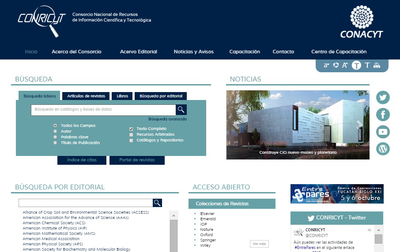With 17 years in publishing sales in the Latin American and Caribbean region, I thought I had seen it all. However, ours is one of those rare industries in which one is often pleasantly surprised. This is the story of how one of publishing company Springer´s largest Latin American consortium customers came to reinvent acquisitions for its members, overcoming years of issues.
After false starts, success
Consortia open up access to research, encourage innovation and usage, and play a tremendous role in developing scientific publishing in regions and countries where progress is needed. That´s not news, but what´s striking in the case of Mexico-and it´s Consorcio Nacional de Recursos de Información Científica y Tecnologíca/National Consortium of Scientific and Technological Information Resources (CONRICyT) in particular-is how a country that had tried unsuccessfully for a number of years to set up a national consortium for the purchase of scientific electronic resources turned its fate around. Until 2011, for a variety of reasons-budget constraints and lack of organization, accountability, and content champions among them-success seemed to elude several attempts at getting consortia purchasing off the ground.
Not only did CONRICyT triumphantly establish their consortium, they did so by building upon the experiences of consortia around them, such as Coordenação de Aperfeiçoamento de Pessoal de Nível Superior/Coordination for the Improvement of Higher Education Personnel (CAPES) in Brazil, Consorcio para el Acceso a la Información Científica Electrónica/Consortium for the Access of Scientific Electronic Information (CINCEL) in Chile, and Ministerio de Ciencia, Tecnología e Innovación Productiva/Ministry of Science, Technology and Productive Innovation (MINCYT) in Argentina. They then developed their own operation model that has proven extremely efficient and yielded rapid results.
The constitution of CONRICyT is based upon access to specialized scientific material, which contributes to the generation of new knowledge and the development of research in Mexico. With that purpose in mind, in September 2010, nine institutions signed a Collaboration Agreement to formally create CONRICyT. These included Mexico´s National Council for Science and Technology, its Ministry of Education, and its National Association of Universities and Higher Education Institutions. The new consortium sought to strengthen the capabilities of its member institutions of higher education and research centers, so that their scientific and technological knowledge would become available to students, academics, researchers, and other users. It also desired to increase, consolidate, and facilitate access to scientific and technological information in digital formats.
At first the consortium was set up using a common model-or at least one that is familiar to any librarian working in this type of environment. It involved buying content based on feedback from researchers and faculty as to what they needed for their work. However, those hoping to make the next great discovery understandably want every resource at their disposal. We found that making content decisions based on a wish list can lead to wasting money on unnecessary resources. In other words, purchasing decisions weren´t always based on practical evidence.
A new model built on measurement and institutional commitment cracked the purchasing code for this young but strong coalition. Now, any institution that wants content purchased by the consortium must essentially "put its money where its mouth is." If there are certain resources that member institutions wish to fund under the consortia budget, they have to first buy the data themselves or prove its value. After a set period of time, a usage analysis parses out the demand for the information. After evaluating those patterns and considering librarian and user feedback, a committee made up of the members themselves decides on the outcome of the request. In essence, a champion for any given resource must step into the ring and appeal for the content, proving that it is required and beneficial for all, or for a specific group of relevant members.
Springer lends a hand
Where in the process does Springer get involved? We see ourselves as not just a vendor but rather a partner to these important customers; therefore, we provide as much support as possible. This often takes the form of supplying data for evaluation but also of negotiating how we execute deals. We understand that in today´s environment of reduced budgets customers need to make the most informed decisions possible; we welcome and encourage active engagement.
CONRICyT not only works efficiently but, above all, is a consortium in which members are accountable for the acquired purchases and the use of that content. They share in and impact decision making. This transparency is evident to those involved and essential to how well this model has worked. The results have been astounding.
In the first year of the new arrangement, readers in Mexico accounted for 54 percent of Springer´s 22.3 million ebook downloads in Latin America and the Caribbean. Brazil was a distant second at 15 percent, and Colombia third at 13 percent. Since the consortium started, Springer ebook downloads in Mexico have increased by 1,860 percent compared to the regional average increase of 1,471 percent. CONRICyT founders are among the institutions with the highest use in Mexico.
Looking back four years later, it´s clear that one of the last countries in the region to establish its own national consortium made the most of the wait by learning from neighboring nations. As a seasoned sales rep for the area, I could not be more ecstatic about the achievement and amazed at the growth.












